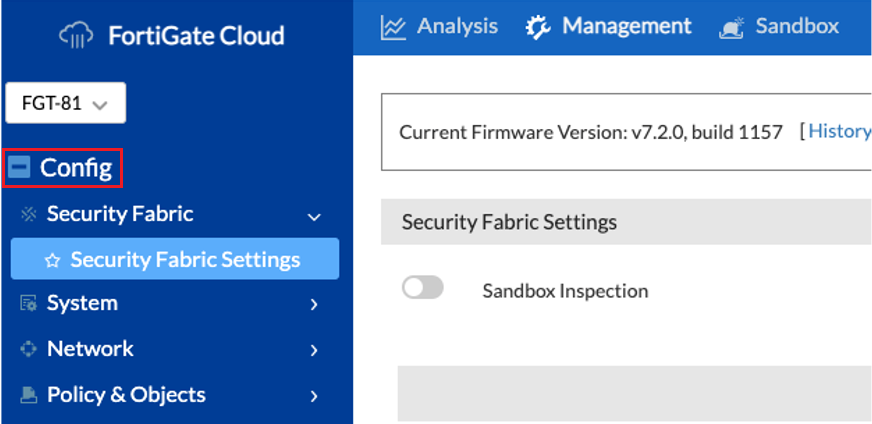Basic FortiGate Cloud Navigation
By default, the FortiGate Cloud page opens the Network Overview tab, which shows a list of all the managed FortiGates. Clicking on the name or serial number loads a context menu with three items:
-
Analysis
-
SandBox
-
Management
In addition to the context menu, there are three icons on the right of the table:

|
|
The Sync Device Status icon forces an immediate synchronization of the FortiGate and FortiGate Cloud. |
|
|
The Remote Access icon logs directly into the FortiGate web UI—as opposed to using the FortiGate Cloud UI. |
|
|
The Config icon exposes a context menu that enables renaming and other management options. |
Understanding FortiGate Cloud Management
Click on the FortiGate name or serial number and choose Management.

The Config page loads. Note that a FortiCloud managed FortiGate can still be configured directly on the FortiGate, rather than via the cloud interface. The configuration shown in FortiGate Cloud does not auto-refresh, so you must be careful about synchronizing configuration changes. FortiGate Cloud displays a notification if the current local FortiGate configuration differs from the latest configuration uploaded to FortiGate Cloud.
To overwrite the FortiGate Cloud configuration with the current local FortiGate configuration, click Import.
To merge the two configurations, click Merge.
When merging the configurations, if there is a conflict between them (for example, an option is enabled locally on the FortiGate but disabled in FortiGate Cloud), FortiGate Cloud keeps the local FortiGate Cloud configuration for that option. You can then make any changes desired to reflect on the device and click Deploy to push the configuration to the FortiGate.
If the current device configuration does not match the configuration stored in FortiGate Cloud, FortiGate Cloud may display a "Device config version does not match device firmware version" message. You can click the Import button to synchronize the cloud configuration and then make changes to deploy to the FortiGate. If you have already have the configuration in FortiGate Cloud that you want, you can use the Deploy button to overwrite the configuration on the FortiGate.

Other important menu items are on the navigation menu. Note there is a drop-down box for switching between FortiGates when dealing with multiple sites, followed by a Config section. The config section parallels the menu items locally available in a FortiGate.





